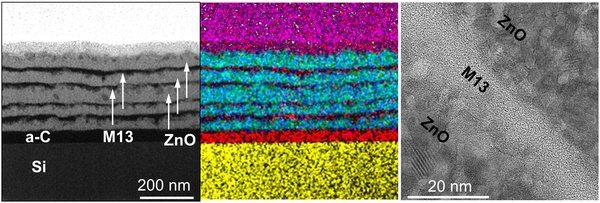
Genetically Optimized M13 Phages as Functionalized Bio-templates for the Generation of Bio/Inorganic Nanostructured Materials
Genetic engineering of M13 bacteriophages offers opportunities for creating novel bio-nanomaterials. Phages can be engineered to recognize and bind to targeted materials, a process referred to as mineralization. In addition, the well-defined, elongated shape of M13 phages can catalyze self-assembly of ordered nanostructures in the form of layers of aligned nanoparticles; these have promising applications in energy systems, biosensors, and electronics. In this project, we study nanoparticle assembly and demonstrate that assembled phage layers can serve as biologically controllable templates for nucleation, growth and alignment of different inorganic nanoparticles over a large length range. In this work, M13 bacteriophages are being employed for controlled mineralization with zinc oxide (ZnO), titania (TiO2) and gold (Au). Our strategy is to construct multilayered nanostructures of alternating organic and phage-templated inorganic layers. Using advanced electron microscopy methods, the structure, elemental composition, and the integrity of the inorganic layers are characterized. The key objective of this study is to determine the factors involved in the formation of the organic/inorganic multilayers and those that determine the chemical and electronic structure at the interfaces between the different layers.
Financial support by the DFG for funding SPP 1569 is gratefully acknowledged. This research has received funding from the European Union Seventh Framework Programme [FP7/2007-2013] under grant no. 312483 (ESTEEM2).
This project is carried out in collaboration with researchers from University of Stuttgart and Karlsruhe Institute of Technology.